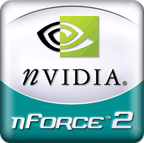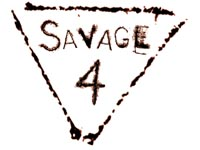HyperTransport (HT), formerly known as Lightning Data Transport (LDT), is a technology for interconnection of computer processors. It is a bidirectional serial/parallel high-bandwidth, low-latency point-to-point link that was introduced on April 2, 2001. The HyperTransport Consortium is in charge of promoting and developing HyperTransport technology.

ATI Technologies Inc. was a Canadian semiconductor technology corporation based in Markham, Ontario, that specialized in the development of graphics processing units and chipsets. Founded in 1985 as Array Technology Inc., the company listed publicly in 1993. Advanced Micro Devices (AMD) acquired ATI in 2006. As a major fabrication-less or fabless semiconductor company, ATI conducted research and development in-house and outsourced the manufacturing and assembly of its products. With the decline and eventual bankruptcy of 3dfx in 2000, ATI and its chief rival Nvidia emerged as the two dominant players in the graphics processors industry, eventually forcing other manufacturers into niche roles.

In a computer system, a chipset is a set of electronic components in an integrated circuit known as a "Data Flow Management System" that manages the data flow between the processor, memory and peripherals. It is usually found on the motherboard. Chipsets are usually designed to work with a specific family of microprocessors. Because it controls communications between the processor and external devices, the chipset plays a crucial role in determining system performance.

nForce is a motherboard chipset created by Nvidia originally for AMD Athlon and Duron, with later revisions also supporting contemporary Intel processors. The chipset shipped in 3 varieties; 220, 415, and 420. 220 and 420 are very similar with each having the integrated GPU, but the 220 only has a single channel of memory available whereas 420 has the 128-bit TwinBank design. The 415 variant again has the dual-channel memory interface, but has no integrated graphics.

The nForce2 chipset was released by Nvidia in July 2002 as a refresh to the original nForce product offering. The nForce2 chipset was a platform for motherboards supporting AMD's Socket A CPUs along with DDR SDRAM. There were variations of the chipset including one with and one without an integrated GeForce4 MX graphics processor (IGP).

The GeForce 6 series is Nvidia's sixth generation of GeForce graphic processing units. Launched on April 14, 2004, the GeForce 6 family introduced PureVideo post-processing for video, SLI technology, and Shader Model 3.0 support.

The nForce4 is a motherboard chipset released by Nvidia in October 2004. The chipset supports AMD 64-bit processors and Intel Pentium 4 LGA 775 processors.

Savage was a product-line of PC graphics chipsets designed by S3.

Diamond Multimedia is an American company that specializes in many forms of multimedia technology. They have produced graphics cards, motherboards, modems, sound cards and MP3 players, however the company began with the production of the TrackStar, a PC add-on card which emulated Apple II computers. They were one of the major players in the 2D and early 3D graphics card competition throughout the 1990s and early 2000s.

The GeForce 7 series is the seventh generation of Nvidia's GeForce graphics processing units. This was the last series available on AGP cards.
The Radeon Xpress 200 is a computer chipset released by ATI. The chipset supports AMD 64-bit processors as well as supporting Intel Pentium 4, Pentium D and Celeron processors. Additionally, it includes support for DDR400 RAM and DDR-2 667 RAM on the Intel Edition.

The ATI Rage is a series of graphics chipsets offering graphical user interface (GUI) 2D acceleration, video acceleration, and 3D acceleration. It is the successor to the ATI Mach series of 2D accelerators.
The nForce 500 is a motherboard chipset series and the successor to the nForce4 series. It was revealed by NVIDIA on 2006-03-07 and released on May 23, 2006. The nForce 500 series supports AMD's Socket AM2 and support for Intel's LGA 775 has also been added.
The Xpress 3200 is a new revision of the Xpress 200 computer chipset released by ATI. The chipset supports AMD64 processors for Socket 939 and Socket AM2.
AMD 580 chipset series is a computer chipset series designed by the AMD Graphics Product Group, for the AMD processors. It was designed for usage with ATI's CrossFire Multi GPU Technology, with both PCI Express slots running at x16 lanes each.
The nForce 600 chipset was released in the first half of November 2006, coinciding with the GeForce 8 series launch on November 8, 2006. The nForce 600 supports Intel's LGA 775 socket and AMD's Quad FX platform and replaces the nForce 500 series.
The AMD 700 chipset series is a set of chipsets designed by ATI for AMD Phenom processors to be sold under the AMD brand. Several members were launched in the end of 2007 and the first half of 2008, others launched throughout the rest of 2008.
Intel's Skulltrail is an enthusiast gaming platform that was released on February 19, 2008. It is based on the company's 5400 "Seaburg" workstation chipset. The primary difference between Skulltrail and Intel's current and past enthusiast chipsets is a dual CPU socket design that allows two processors to operate on the same motherboard. Therefore, Skulltrail can operate eight processing cores on one system. The platform supports two Core 2 Extreme QX9775 processors, which operate at 3.2 GHz.
The Namco System N2 arcade platform runs on an nForce2-based motherboard that NVIDIA developed. It is based on a NVIDIA GeForce graphics card, using the OpenGL API.










